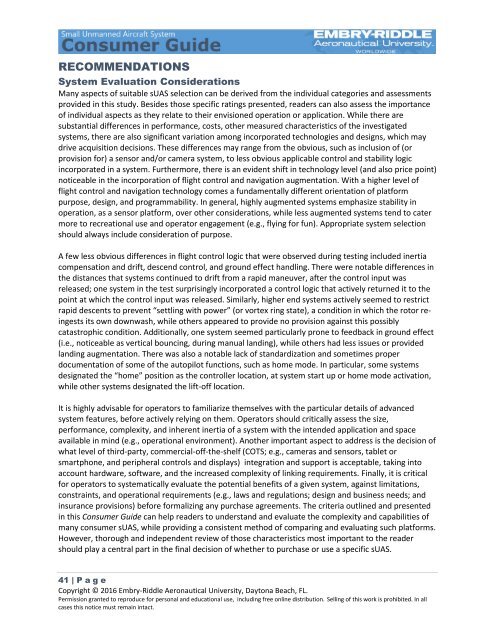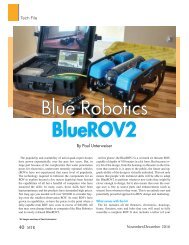ACKNOWLEDGEMENTS
erau-suas-consumer-guide-june-2016-release
erau-suas-consumer-guide-june-2016-release
You also want an ePaper? Increase the reach of your titles
YUMPU automatically turns print PDFs into web optimized ePapers that Google loves.
RECOMMENDATIONS<br />
System Evaluation Considerations<br />
Many aspects of suitable sUAS selection can be derived from the individual categories and assessments<br />
provided in this study. Besides those specific ratings presented, readers can also assess the importance<br />
of individual aspects as they relate to their envisioned operation or application. While there are<br />
substantial differences in performance, costs, other measured characteristics of the investigated<br />
systems, there are also significant variation among incorporated technologies and designs, which may<br />
drive acquisition decisions. These differences may range from the obvious, such as inclusion of (or<br />
provision for) a sensor and/or camera system, to less obvious applicable control and stability logic<br />
incorporated in a system. Furthermore, there is an evident shift in technology level (and also price point)<br />
noticeable in the incorporation of flight control and navigation augmentation. With a higher level of<br />
flight control and navigation technology comes a fundamentally different orientation of platform<br />
purpose, design, and programmability. In general, highly augmented systems emphasize stability in<br />
operation, as a sensor platform, over other considerations, while less augmented systems tend to cater<br />
more to recreational use and operator engagement (e.g., flying for fun). Appropriate system selection<br />
should always include consideration of purpose.<br />
A few less obvious differences in flight control logic that were observed during testing included inertia<br />
compensation and drift, descend control, and ground effect handling. There were notable differences in<br />
the distances that systems continued to drift from a rapid maneuver, after the control input was<br />
released; one system in the test surprisingly incorporated a control logic that actively returned it to the<br />
point at which the control input was released. Similarly, higher end systems actively seemed to restrict<br />
rapid descents to prevent “settling with power” (or vortex ring state), a condition in which the rotor reingests<br />
its own downwash, while others appeared to provide no provision against this possibly<br />
catastrophic condition. Additionally, one system seemed particularly prone to feedback in ground effect<br />
(i.e., noticeable as vertical bouncing, during manual landing), while others had less issues or provided<br />
landing augmentation. There was also a notable lack of standardization and sometimes proper<br />
documentation of some of the autopilot functions, such as home mode. In particular, some systems<br />
designated the “home” position as the controller location, at system start up or home mode activation,<br />
while other systems designated the lift-off location.<br />
It is highly advisable for operators to familiarize themselves with the particular details of advanced<br />
system features, before actively relying on them. Operators should critically assess the size,<br />
performance, complexity, and inherent inertia of a system with the intended application and space<br />
available in mind (e.g., operational environment). Another important aspect to address is the decision of<br />
what level of third-party, commercial-off-the-shelf (COTS; e.g., cameras and sensors, tablet or<br />
smartphone, and peripheral controls and displays) integration and support is acceptable, taking into<br />
account hardware, software, and the increased complexity of linking requirements. Finally, it is critical<br />
for operators to systematically evaluate the potential benefits of a given system, against limitations,<br />
constraints, and operational requirements (e.g., laws and regulations; design and business needs; and<br />
insurance provisions) before formalizing any purchase agreements. The criteria outlined and presented<br />
in this Consumer Guide can help readers to understand and evaluate the complexity and capabilities of<br />
many consumer sUAS, while providing a consistent method of comparing and evaluating such platforms.<br />
However, thorough and independent review of those characteristics most important to the reader<br />
should play a central part in the final decision of whether to purchase or use a specific sUAS.<br />
41 | P a g e<br />
Copyright © 2016 Embry-Riddle Aeronautical University, Daytona Beach, FL.<br />
Permission granted to reproduce for personal and educational use, including free online distribution. Selling of this work is prohibited. In all<br />
cases this notice must remain intact.



